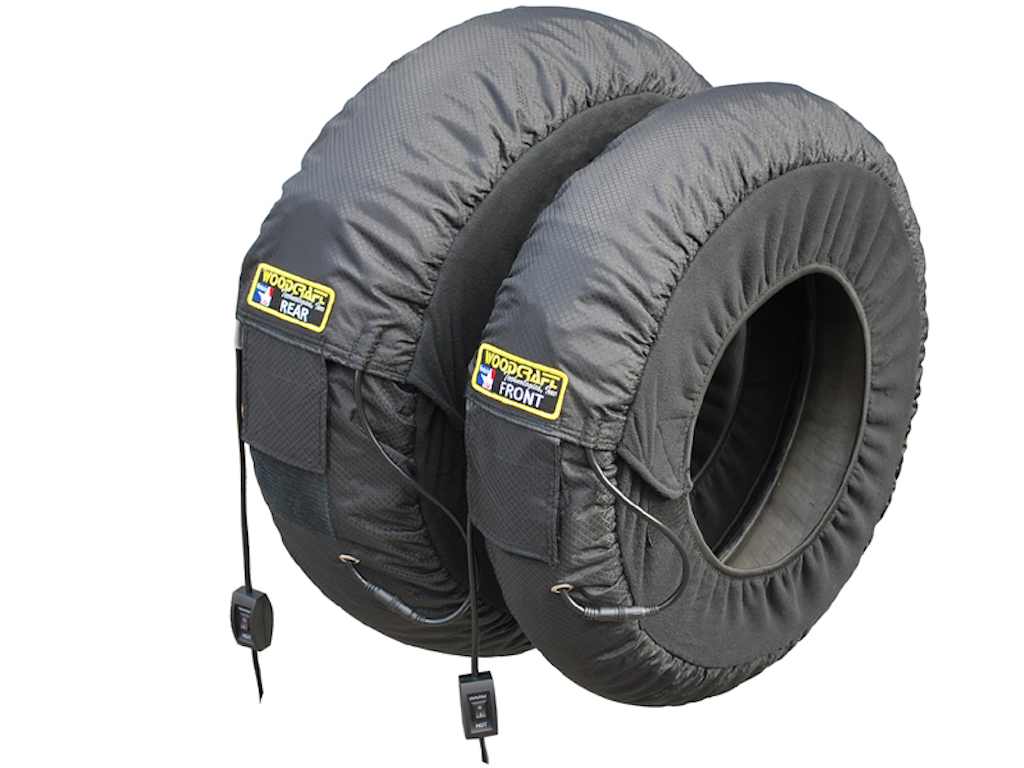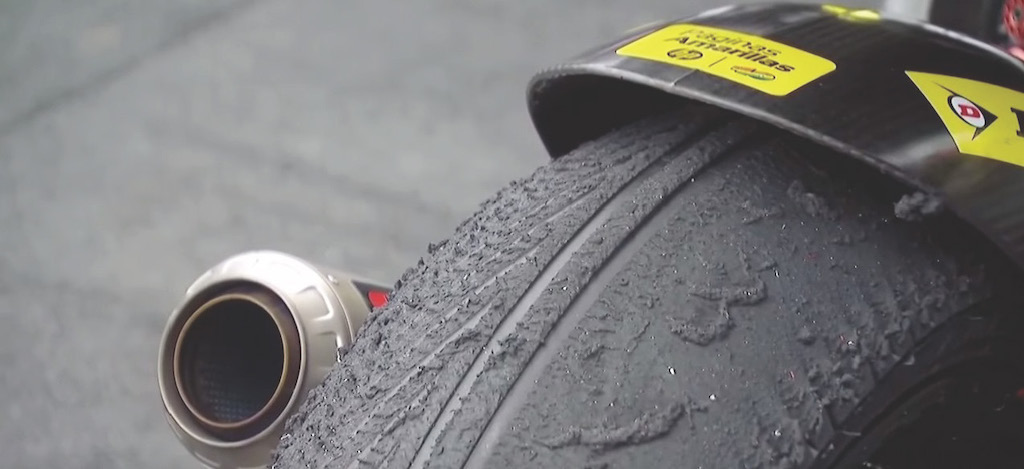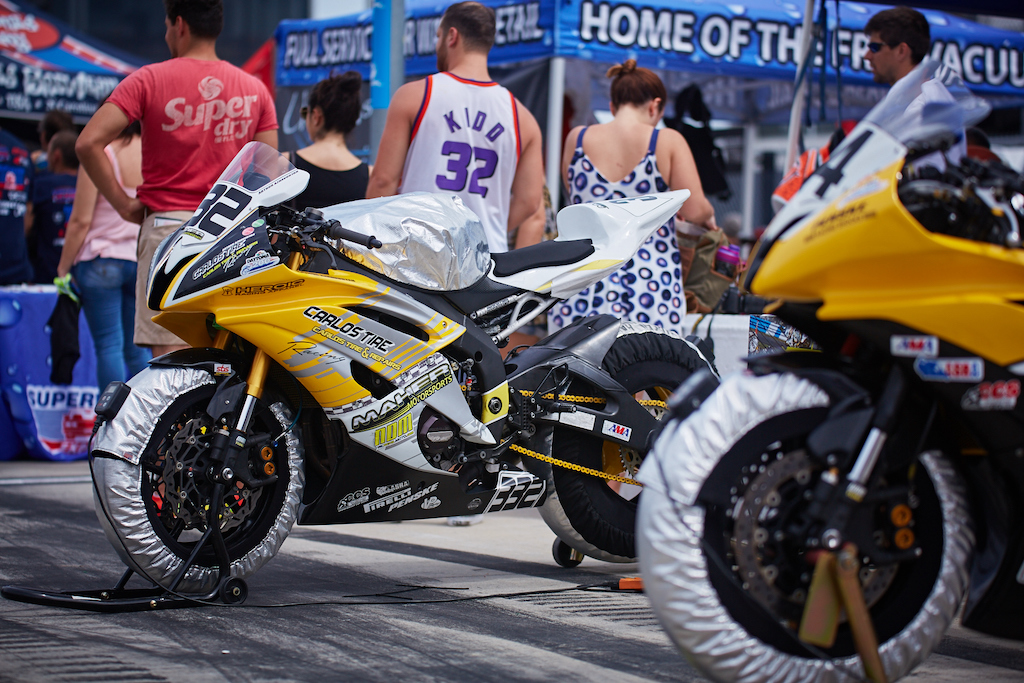
Over the years I’ve heard the racetrack compared to many different things, but a “traditional” sport that seems to parallel track day riding or racing closely is skiing (or snowboarding as you may prefer). Participants in both sports take off, often for a couple of days, with a mountain of gear packed away in their vehicles to go out and get as many laps (or runs) as their wallet and physical stamina can afford. Racetracks, like ski mountains, are often several hours away and the dedicated lovers of these sports allocate valuable money and time in the quest for speed, thrills and good times with their friends. In both sports, spending a little money in the right places can improve your speed, handling and confidence. However, there are always points of diminishing return. A novice skier like me is likely not going to be able to benefit from using Bode Miller’s downhill skis from the last Olympics, just like your average track day rider would likely go faster on a good supersport bike than on Jorge Lorenzo’s M1. However, one tool that is available to motorcycle riders can be a benefit to riders at most any level when used properly. In this article, we will discuss the features, benefits and uses of tire warmers.
Like a good wax on a set of skis, sticky tires benefit riders at any level. Everything you do to your bike to make it go faster or handle better is translated to the track through your tires. If I could make one modification to any street bike to make it handle better, I would choose race tires every time. By raising the ultimate grip level of your bike, expert riders can ride faster and newer riders have a larger margin for error. The only real sacrifice a rider makes when switching to race tires is that they require tire warmers.

Regardless of what tires riders at Penguin School events run, we frequently get questions regarding the need for and the use of tire warmers. In the end, there are two major factors that influence the use of tire warmers; tire type and weather conditions.
Street Tires
Can you do a track day on stock tires? Absolutely! They have lower ultimate grip than race tires, and in testing, we find that a street tire might be 3 to 4 seconds a lap off of a race tire. However, since most track day riders ride at 15-20 seconds a lap off of race times they have plenty of grip to spare… as long as they don’t upset the chassis with unintended bar input. Since stock tires are meant to operate at relatively low operating temperatures, tire warmers are not recommended. The rubber compounds for these tires are made so that when you roll out of the garage on a crisp 45-degree spring day you still have some traction to work with. However, since all rubber has a limited range of temperature it can work with, once these tires get above the 130-degree range they start to get very “greasy”. The rubber begins to “melt” off the surface and the bike begins to slide very easily.
The photo below shows a rain tire (also designed to operate at low temperature) used on a dry track. The rubber literally just begins to peel off the surface when the ideal temperature is exceeded. If you put your hand on a street tire after riding on the road, it feels warm, but not “hot”. This is ideal. However, since tire warmers (even multi-temperature ones) heat tires between 135 and 180 degrees (or more) it’s easy to see why tire warmers are not the way to go in any weather.

The fastest way to put heat into a tire is by hard acceleration or hard braking. When street tires are used on a track (where riders can finally brake and accelerate with vigor) they quickly generate too much heat. As soon as you start to keep up with the pack at a track day, chances are you are already overworking a set of stock tires.
Track Day Tires
A recent category of track day tires (like the Dunlop Q3) are superior to most stock tires, yet they do not require warmers in order to work well. These tires will still work reasonably well when they are colder and can handle a higher ultimate temperature before they begin to “melt” like the stock units. Tires in this street/track hybrid class are a great choice for riders without warmers. On a cool day, I would still use a set of warmers on these tires, but I would only use them on the “low” temperature setting on my warmers (135 to 140 degrees).
Race Tires
Race tires offer more grip, more stability, more confidence and are worth more time than any other modification you can make. However, since they are designed to operate at higher temperatures they are terrible when they are cold. Since most race tires are meant to operate between 150 and 180 degrees, race tires need to run on tire warmers any time you use them. Without warmers, it can take 2 to 3 laps to get the tires up to temperature on a warm day and they may never come up to temperature on a cold day (in my experience, below 60 degrees). A major factor is the temperature of the pavement. If you put your hand on the asphalt and it warms your hand, you’ll likely be able to get race tires to work as long as you are smooth for a couple of laps. If the pavement sucks the heat out of your hand, expect slippery tires for a majority of the session.
With all the time, effort, and expense to get to the track it seems crazy to waste 20 to 30% of your time on the track warming up your tires. It’s like going to the mountain and making your first few runs with one ski. If you are going to invest in race tires to maximize your traction, then tire warmers are a must.
Tire Warmers Use
The most common misconception with tire warmers is that they are primarily used to heat up the surface of the tire. While this is certainly one valid reason, it is equally (if not more important) to heat up the carcass of the tire. I’m amazed from time to time when riders insist on using a digital temperature gauge and will not roll out of the garage until the gauge indicates 180 (or whatever their target temperature is). If these riders checked the surface temperature again after sitting on pit lane in the wind for 60 seconds waiting to go out, they’d be shocked to see that the surface temp can drop up to 30 to 40 degrees in a short time!
The most important thing to remember when warming up a tire is that you need to “heat soak” the carcass. This takes anywhere from 45 to 60 minutes depending on the ambient temperature. This will allow your tire to hold the temperature and allow the rider to ride with confidence. It is far less important for your tire to be exactly 180 degrees than it is for the carcass to be fully heat soaked. It takes at least 45 minutes for this to happen in most all conditions.
Tire Warmers on Cold and/or Windy Days
On cold days, your enemy is the wind. When Woodcraft tested tire warmers many years ago, we played with all kinds of insulation. The end result was that the difference between average insulation on warmer and crazy insulation (try 4 warmers stacked on top of each other) was actually very small on the ability of the warmer to retain heat. However, when we installed curtains on the side of the tire to block the wind, edge temperatures shot up 20 degrees (or more, depending on the day). Regardless of the brand of warmer (I’ve tried them all), on a day that it’s cold outside, I always wrap the tire warmer up with a wheel wrap or a blanket.

On a cold day, spend the least amount of time on pit lane as possible. When I hit the track on a cool day with completely heat soaked tires, I go right out at the last second and ride hard right from the start. On particularly cool days, the tires will slowly cool down with every lap. Be particularly careful late in the session on the first non-dominant corner after a long straight (for example a left-hand corner on a clockwise track) as that is where most of the crashes are likely to occur.
In the end, race tires have the most grip, but there is a price to pay for the traction that they offer. The decision is up to you!
Images: Michael Spain-Smith

About The Author
Discover more from SportBikes Inc Magazine
Subscribe to get the latest posts sent to your email.


2 thoughts on “Tire Warmers – Do You Need Them?”